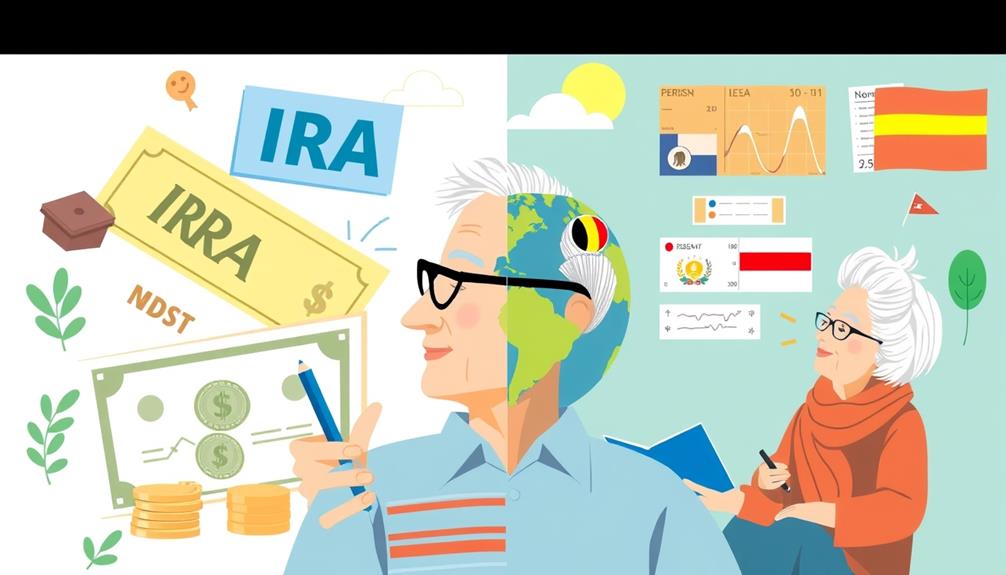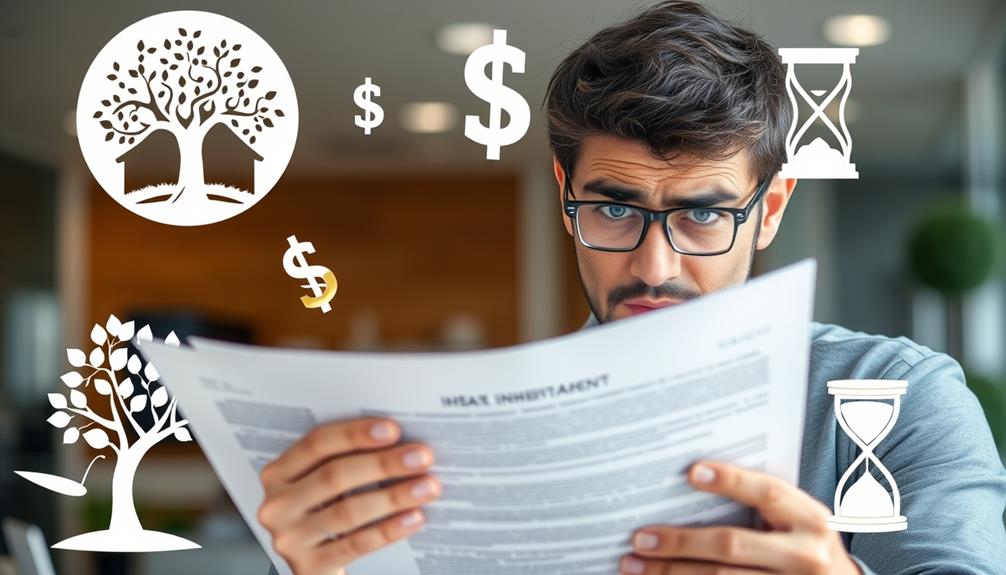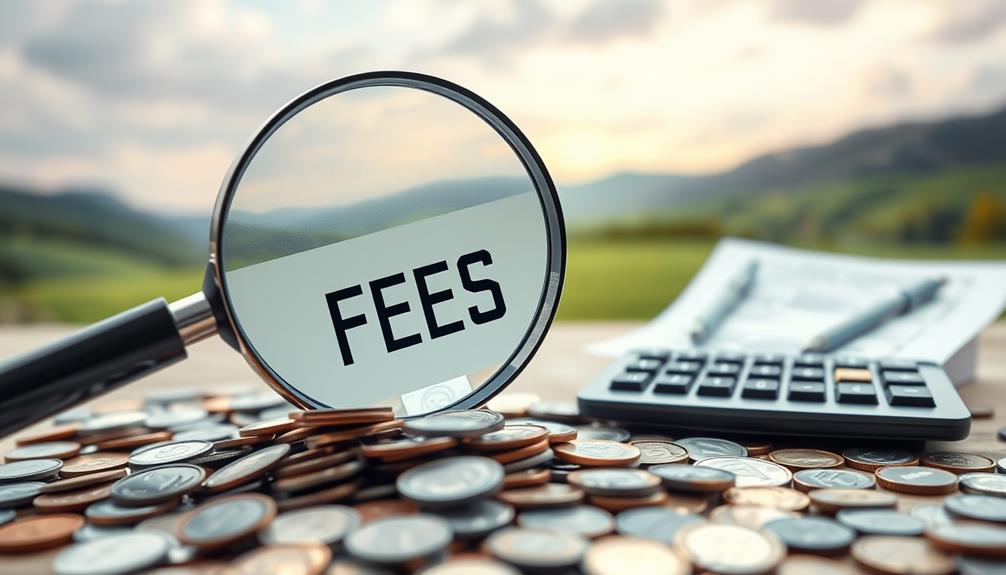You can grow your wealth while making a positive impact by using your IRA for sustainable investing. With tax-deferred growth or tax-free withdrawals through a Roth IRA, you'll have diverse options like green bonds and renewable energy companies at your fingertips. Investing in fossil fuel-free funds or gender equality initiatives supports Environmental, Social, and Governance criteria. You also get to decide where your money goes with self-directed IRAs. Not only do you have the chance to see returns, but you also contribute to a healthier planet. Explore how you can align your investments with your values for greater impact.
Key Takeaways
- Use your IRA for tax-deferred growth while investing in green bonds or renewable energy companies.
- Self-directed IRAs allow you to directly choose sustainable investments aligned with your values.
- Sustainable investing contributes to positive social and environmental impacts, enhancing long-term viability.
- Engage with financial professionals to identify ESG-focused funds that align with your ethical priorities.
- Leverage crowdfunding platforms for accessible investments in community projects and initiatives supporting sustainability.
Understanding Sustainable Investing

Sustainable investing has become a key approach for many investors, blending financial goals with a commitment to positive social and environmental impact. By integrating environmental, social, and governance (ESG) factors into your investment decisions, you're not just aiming for financial returns; you're also contributing to a healthier planet and society.
As part of this movement, many investors are exploring Gold IRA options as a way to diversify their portfolios while focusing on sustainable assets. As of 2021, ESG-focused investment funds manage over $17 trillion in assets, demonstrating strong market interest in sustainable investing.
You have various investment options to choose from, including exclusionary screening to avoid unethical sectors, impact investing that targets measurable outcomes, and community investing that directs capital to underserved communities. Each of these strategies allows you to align your portfolio with your values while seeking to achieve solid financial performance.
However, it's important to recognize some challenges. The rise of shareholder activism emphasizes the demand for better corporate accountability regarding ESG practices, yet a lack of standardized metrics for measuring ESG performance can complicate your decision-making.
Additionally, you should remain vigilant about greenwashing, where companies exaggerate their sustainability efforts. Understanding these dynamics will empower you to engage meaningfully in sustainable investing while making a positive climate impact.
Benefits of Using Your IRA

Investing through your IRA not only lets you pursue financial growth but also aligns your investments with your values. By utilizing your retirement account for sustainable investing, you can enjoy unique advantages that benefit both your wallet and the planet.
Additionally, consider diversifying your portfolio with assets like gold, which can protect against inflation and market downturns while also providing tax advantages available when rolling over 401k to Gold IRA.
Here are some key benefits of using your IRA for sustainable investments:
- Tax Advantages: Enjoy tax-deferred growth or tax-free withdrawals with a Roth IRA.
- Diverse Options: Invest in green bonds, renewable energy companies, and community projects.
- Align with ESG Criteria: Support Environmental, Social, and Governance factors, which are crucial for long-term viability.
- Self-Directed Flexibility: With a self-directed IRA, you can choose and control your sustainable investment options directly.
- Positive Impact: Contribute to renewable energy initiatives and local community development, making a real difference in society.
Types of Sustainable Investment Options

When considering your investment options, you'll find a variety of sustainable choices that align with your values and financial goals. One popular choice is Fossil Free Funds, which allow you to direct your retirement savings away from companies involved in fossil fuel extraction.
Additionally, it's crucial to research companies thoroughly before investing to avoid potential scams and guarantee they align with your sustainable values, as highlighted by the importance of avoiding gold IRA scams.
If you're passionate about social justice, Gender Equality Funds invest in companies that promote diversity and gender equity, merging ethical investing with potential financial returns.
For those who prioritize non-violence, Gun Free Funds focus on businesses that don't engage in firearms manufacturing, while Military Weapon Free Funds support peace-oriented values by avoiding investments in military weapon production.
If environmental conservation is important to you, consider Deforestation Free Funds, which target companies committed to sustainable practices that protect forests.
These options represent just a fraction of the socially responsible investing landscape. By exploring these investment options, you can build a portfolio that not only aims for financial growth but also reflects your personal beliefs and values.
Sustainable investing with your IRA empowers you to make a positive impact while preparing for your financial future.
Strategies for Impactful Investing

When you're looking to maximize the impact of your investments, consider regenerative opportunities that not only yield returns but also benefit the environment.
Incorporating strategies such as gold investment strategies into your portfolio can provide a hedge against market volatility while supporting sustainable practices.
Diversifying your portfolio with these options can enhance financial stability while aligning with your values.
Let's explore how you can integrate these strategies into your sustainable investing approach.
Regenerative Investment Opportunities
Amid growing concerns about climate change and social inequality, regenerative investment opportunities present a compelling way to make a positive impact while potentially earning returns.
By utilizing vehicles like Self-Directed IRAs (SDIRAs), you can invest in projects that focus on environmental and social benefits. Additionally, understanding the financial factors involved in such investments is essential for maximizing impact and sustainability, especially for those evaluating financial assistance for elderly care.
Here are some avenues to explore:
- Community farms: Support local food production and sustainable agriculture.
- Sustainable real estate: Invest in properties that promote environmental conservation and social justice.
- Wefunder: Get involved with startups that have social missions, starting with as little as $10.
- Kachuwa Impact Fund: Combine elements of REITs and mutual funds with a minimum investment of $5,000.
- Streetshares Veterans bonds: Earn 5% interest while supporting local and veteran-owned businesses.
Diversifying Your Portfolio
How can you effectively diversify your portfolio while making a positive impact? By incorporating sustainable investments into your retirement plan, you can reduce risk and align your financial goals with your values. The growth of over $17 trillion in ESG-focused assets shows that there are plenty of investing options available to you.
Additionally, consider how Gold IRAs provide a hedge against inflation while promoting economic stability, enhancing your overall investment strategy.
Consider utilizing a self-directed IRA (SDIRA) to access a range of socially responsible investments, such as community projects and green businesses. This strategy not only gives you control over your choices but also supports initiatives that promote sustainability.
You can also engage in impact investing strategies by allocating funds to companies with strong environmental practices or supporting local regenerative projects. This approach can yield financial returns while providing measurable social benefits.
Don't forget to research and incorporate funds that focus on low-carbon or fossil fuel-free investments. This helps enhance your portfolio's sustainability while addressing the financial risks associated with traditional fossil fuel companies.
Crowdfunding for Sustainable Initiatives

When you're looking to invest in sustainable initiatives, crowdfunding platforms can be a great option for getting involved with lower minimum investments.
These platforms often feature projects that emphasize sustainability and responsible investing, aligning perfectly with the growing demand for environmentally conscious choices.
However, it's essential to conduct thorough due diligence, as the quality of these platforms and opportunities can vary widely.
Crowdfunding Platforms Overview
Crowdfunding platforms are revolutionizing the way you can invest in sustainable initiatives, offering a unique opportunity to support environmentally friendly projects with minimal financial commitment.
With platforms like Wefunder and TruCrowd, you can start investing with as little as $10 or $25, making it accessible for everyone. Additionally, many of these platforms continuously update their offerings, reflecting new and innovative sustainable projects that align with your values, which can be found in best websites to earn money online.
Here are some key benefits of crowdfunding for sustainable initiatives:
- Low Minimum Investments: You don't need a fortune to get started.
- Community Focus: Many projects support local farms or renewable energy startups.
- Diverse Opportunities: Invest in various sectors, from clean tech to sustainable agriculture.
- Engagement: Successful campaigns foster community awareness around environmental issues.
- Regulatory Flexibility: Recent changes in regulations allow for more social and environmental projects.
However, while crowdfunding can be rewarding, it's essential to perform due diligence.
The quality of platforms varies, so stick to established names for reliable investment opportunities. Remember, it's always wise to seek investment advice when traversing this landscape.
Due Diligence Importance
Investing in sustainable initiatives through crowdfunding can be exciting, but it's vital to conduct thorough due diligence to protect your interests. The crowdfunding landscape can feel like the "wild west," with platforms varying greatly in quality and reliability.
Prioritize reputable platforms like Wefunder, which have better vetting processes and communication, over less reliable options like TruCrowd, known for poor investor updates. Given the potential risks, understanding the concept of investment regulations is also essential when maneuvering such investments.
Understanding the business model and financial health of the projects you're considering is essential. Many startups require a long-term holding period of 3-5 years before you might see potential returns.
Your due diligence should also extend to the crowdfunding platforms themselves, confirming they provide transparency about their investment practices and associated risks.
Additionally, don't underestimate the value of community feedback and investor testimonials. Engaging with these resources can give you valuable insights into the legitimacy and impact of the crowdfunding projects focused on sustainable initiatives.
If you're unsure, consider consulting an investment adviser to help guide your decisions and confirm you're making informed, responsible investments. Remember, thorough due diligence is your best defense against the uncertainties of crowdfunding.
Evaluating Environmental Investments

In today's world, evaluating environmental investments is more essential than ever as you seek to align your financial goals with your values. By appraising companies based on their sustainability efforts, you can make informed decisions that contribute to a healthier planet.
Additionally, exploring initiatives that promote free crypto opportunities can provide innovative ways to support environmental projects while potentially enhancing your investment portfolio.
Here are some critical factors to contemplate when evaluating these investments:
- Carbon Emissions: Look for companies that actively reduce their carbon footprint.
- Resource Management: Analyze how well companies manage natural resources and waste.
- ESG Ratings: Utilize Environmental, Social, and Governance ratings to gauge sustainability performance, but be wary of inconsistencies.
- Fossil Fuel Exposure: Focus on fossil fuel-free funds or low-carbon options to minimize your contribution to climate change.
- Due Diligence: Investigate the regenerative potential of projects to guarantee positive environmental outcomes alongside financial returns.
Using tools like FossilFreeFunds.org can help you identify investment opportunities with high fossil fuel exposure.
Measuring Returns Beyond Financials

Sustainable investments aren't just about the numbers; they can create real change in communities and the environment. While financial returns matter, it's vital to recognize the non-financial rewards that come from your savings invested in sustainable projects.
For instance, the Kachuwa Impact Fund focuses on socially conscious real estate, emphasizing social justice and environmental conservation alongside monetary gains.
When you review your investments, consider evaluating improvements in carbon reduction, social equity, and community resilience. These factors may not have direct financial quantifications, but they play a significant role in determining the true impact of your investments.
The rise of ESG-focused funds, which reported over $17 trillion in assets in 2021, highlights a strong market trend towards prioritizing sustainable outcomes along with financial performance.
Engaging With Financial Professionals

Steering through the complexities of sustainable investing can be intimidating, but engaging with financial professionals makes the journey smoother.
These experts can provide tailored advice that aligns with your values and retirement goals. Here's how they can help you navigate the world of sustainable investing:
- Identify Options: Financial advisors can pinpoint socially responsible funds that resonate with your ethics.
- Evaluate ESG: They'll help you assess the environmental, social, and governance (ESG) performance of potential investments.
- Explore Opportunities: Engaging in discussions about new economy investing can uncover diverse opportunities, even for non-accredited investors through self-directed IRAs (SDIRAs) and Solo 401ks.
- Customize Strategies: Collaborate with professionals to create personalized investment policy statements that reflect your sustainable investing preferences.
- Enhance Due Diligence: Utilize tools and resources provided by financial experts to make informed decisions.
Aligning Investments With Personal Values

Aligning your investments with personal values can transform how you view your financial future. When you choose to invest your money in sustainable options, you're not just chasing profits; you're supporting companies that prioritize environmental sustainability, social justice, and ethical governance.
This approach enhances your personal satisfaction and gives purpose to your financial choices.
Research shows that nearly 85% of millennials are interested in sustainable investing, reflecting a significant trend among younger investors who want their portfolios to align with their ethical beliefs, especially concerning climate change.
Tools like FossilFreeFunds.org make it easier for you to assess and reduce fossil fuel exposure in your retirement accounts, ensuring that your investments mirror your commitment to environmental responsibility.
Frequently Asked Questions
Does ESG Investing Help the Environment?
Yes, ESG investing helps the environment by supporting companies that prioritize sustainable practices. When you invest in these responsible businesses, you encourage positive change, reduce risks associated with climate issues, and potentially earn profitable returns.
Does ESG Investing Actually Make a Difference?
ESG investing drives positive change, supports sustainable practices, and fosters corporate accountability. By choosing these investments, you're not just seeking financial returns; you're actively contributing to a healthier planet and a more equitable society.
Is an IRA the Best Way to Save Money?
An IRA can be a smart way to save money, offering tax advantages that boost your retirement savings. You can grow your investments tax-deferred or tax-free, helping you reach your financial goals more effectively.
Is It Worth Investing in Sustainability?
Imagine your money as a seed; investing in sustainability nurtures growth that flourishes over time. Yes, it's worth investing in sustainability. You're not just securing returns; you're cultivating a healthier planet for future generations.
Conclusion
So, why not turn your IRA into a powerhouse for both your wallet and the planet? Imagine your investments not just growing, but sprouting green leaves while saving endangered species! By embracing sustainable investing, you're not just making money; you're becoming a superhero for Earth—cape optional! Immerse yourself in the options, connect with experts, and watch your portfolio bloom into a force for good. It's time to align your financial goals with your values and change the world, one dollar at a time!










